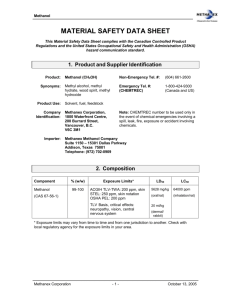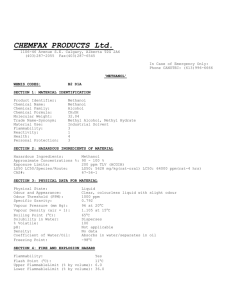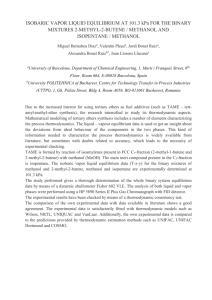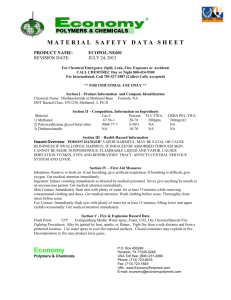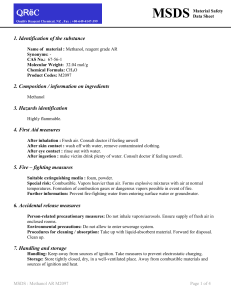Material Safety Data Sheet Instant FAME/Instant Anaerobe Methods Methanol
advertisement
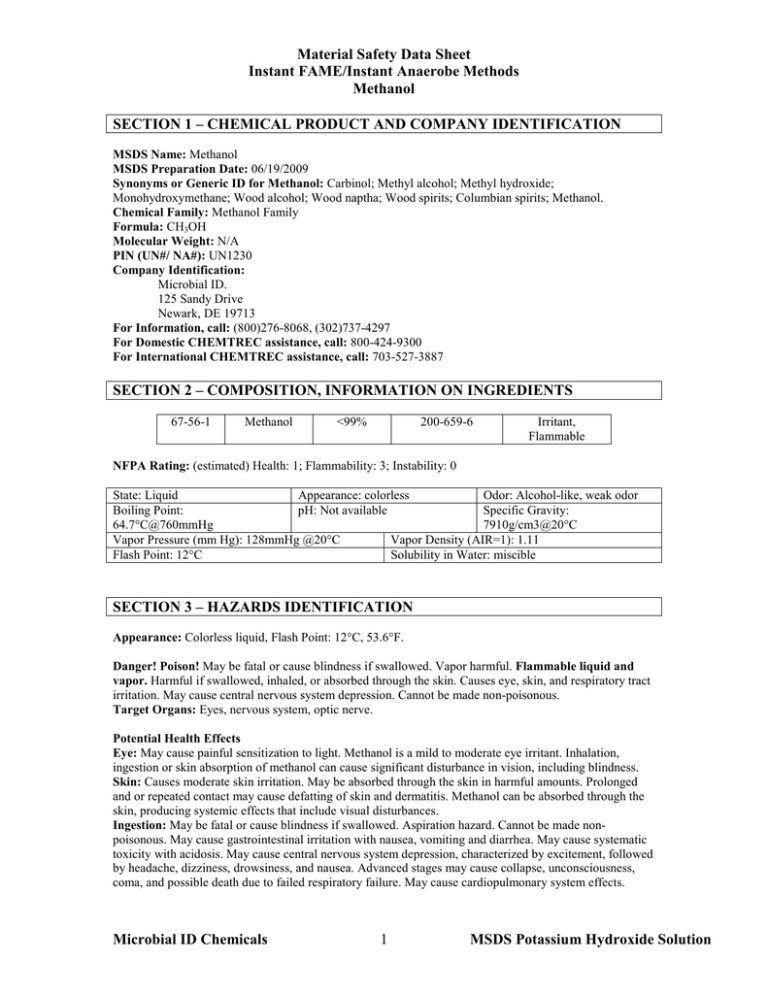
Material Safety Data Sheet Instant FAME/Instant Anaerobe Methods Methanol SECTION 1 – CHEMICAL PRODUCT AND COMPANY IDENTIFICATION MSDS Name: Methanol MSDS Preparation Date: 06/19/2009 Synonyms or Generic ID for Methanol: Carbinol; Methyl alcohol; Methyl hydroxide; Monohydroxymethane; Wood alcohol; Wood naptha; Wood spirits; Columbian spirits; Methanol. Chemical Family: Methanol Family Formula: CH3OH Molecular Weight: N/A PIN (UN#/ NA#): UN1230 Company Identification: Microbial ID. 125 Sandy Drive Newark, DE 19713 For Information, call: (800)276-8068, (302)737-4297 For Domestic CHEMTREC assistance, call: 800-424-9300 For International CHEMTREC assistance, call: 703-527-3887 SECTION 2 – COMPOSITION, INFORMATION ON INGREDIENTS 67-56-1 Methanol <99% 200-659-6 Irritant, Flammable NFPA Rating: (estimated) Health: 1; Flammability: 3; Instability: 0 State: Liquid Appearance: colorless Odor: Alcohol-like, weak odor Boiling Point: pH: Not available Specific Gravity: 64.7°C@760mmHg 7910g/cm3@20°C Vapor Pressure (mm Hg): 128mmHg @20°C Vapor Density (AIR=1): 1.11 Flash Point: 12°C Solubility in Water: miscible SECTION 3 – HAZARDS IDENTIFICATION Appearance: Colorless liquid, Flash Point: 12°C, 53.6°F. Danger! Poison! May be fatal or cause blindness if swallowed. Vapor harmful. Flammable liquid and vapor. Harmful if swallowed, inhaled, or absorbed through the skin. Causes eye, skin, and respiratory tract irritation. May cause central nervous system depression. Cannot be made non-poisonous. Target Organs: Eyes, nervous system, optic nerve. Potential Health Effects Eye: May cause painful sensitization to light. Methanol is a mild to moderate eye irritant. Inhalation, ingestion or skin absorption of methanol can cause significant disturbance in vision, including blindness. Skin: Causes moderate skin irritation. May be absorbed through the skin in harmful amounts. Prolonged and or repeated contact may cause defatting of skin and dermatitis. Methanol can be absorbed through the skin, producing systemic effects that include visual disturbances. Ingestion: May be fatal or cause blindness if swallowed. Aspiration hazard. Cannot be made nonpoisonous. May cause gastrointestinal irritation with nausea, vomiting and diarrhea. May cause systematic toxicity with acidosis. May cause central nervous system depression, characterized by excitement, followed by headache, dizziness, drowsiness, and nausea. Advanced stages may cause collapse, unconsciousness, coma, and possible death due to failed respiratory failure. May cause cardiopulmonary system effects. Microbial ID Chemicals 1 MSDS Potassium Hydroxide Solution Material Safety Data Sheet Instant FAME/Instant Anaerobe Methods Methanol Inhalation: Methanol is toxic and can very readily form extremely high vapor concentrations at room temperature. Inhalation is the most common route of occupational exposure. At first, methanol causes CNS depression with nausea, headache, vomiting, dizziness and incoordination. A time period with no obvious symptoms follows (typically 8-24 hrs). This latent period is followed by metabolic acidosis and severe visual effects which may include reduced reactivity and/or increased sensitivity to light, blurred, doubl and/or snowy vision, and blindness. Depending on the severity of exposure and the promptness of treatment, survivors may recover completely or may have permanent blindness, vision disturbances and/or nervous system effects. Chronic: Prolonged or repeated skin contact may cause dermatitis. Chronic exposure may cause effects similar to those of acute exposure. Methanol is only very slowly eliminated from the body. Because of this slow elimination, methanol should be regarded as a cumulative poison. Though a single exposure may cause no effect, daily exposures may result in the accumulation of a harmful amount. Methanol has produced fetotoxicity in rats and teratogenicity in mice exposed by inhalation to high concentrations that did not produce significant maternal toxicity. SECTION 4 – FIRST AID MEASURES Eyes: In case of contact, immediately flush eyes with plenty of water for a t least 15 minutes. Get medical aid. Skin: In case of contact, immediately flush skin with plenty of water for at least 15 minutes while removing contaminated clothing and shoes. Get medical aid immediately. Wash clothing before reuse. Ingestion: Potential for aspiration if swallowed. Get medical aid immediately. Do not induce vomiting unless directed to do so by medical personnel. Never give anything by mouth to an unconscious person. If vomiting occurs naturally, have victim lean forward. Inhalation: If inhaled, remove to fresh air. If not breathing, give artificial respiration. If breathing is difficult, give oxygen. Get medical aid. Notes to Physician: Effects may be delayed. Antidote: Ethanol may inhibit methanol metabolism. SECTION 5 – FIRE FIGHTING MEASURES General Information: Ethanol may inhibit methanol metabolism. As in any fire, wear a self-contained breathing apparatus in pressure-demand, MSHA/NIOSH (approved or equivalent), and full protective gear. During a fire, irritating and highly toxic gases may be generated by thermal decomposition or combustion. Use water spray to keep fire-exposed containers cool. Water may be ineffective. Material is lighter than water and a fire may be spread by the use of water. Vapors are heavier than air and may travel to a source of ignition and flash back. Vapors can spread along the ground and collect in low or confined areas. Extinguishing Media: For small fires, use dry chemical, carbon dioxide, water spray or alcohol-resistant foam. Water may be ineffective. For large fires, use water spray, fog or alcohol-resistant foam. Do NOT use straight streams of water. Flash Point: 12 deg C ( 53.60 deg F) Autoignition Temperature: 455 deg C ( 851.00 deg F) Explosion Limits, Lower:6.0 vol % Upper: 31.00 vol % NFPA Rating: (estimated) Health: 1; Flammability: 3; Instability: 0 SECTION 6 – ACCIDENTAL RELEASE MEASURES General Information: Use proper personal protective equipment as indicated in Section 8. Spills/Leaks: Use water spray to disperse the gas/vapor. Remove all sources of ignition. Absorb spill using an absorbent, non-combustible material such as earth, sand, or vermiculite. Do not use combustible materials such as sawdust. Use a spark-proof tool. Provide ventilation. A vapor suppressing foam may be used to reduce vapors. Water spray may reduce vapor but may not prevent ignition in closed spaces. Microbial ID Chemicals 2 MSDS Potassium Hydroxide Solution Material Safety Data Sheet Instant FAME/Instant Anaerobe Methods Methanol SECTION 7-HANDLING AND STORAGE Handling: Wash thoroughly after handling. Remove contaminated clothing and wash before reuse. Ground and bond containers when transferring material. Use spark-proof tools and explosion proof equipment. Avoid contact with eyes, skin, and clothing. Empty containers retain product residue, (liquid and/or vapor), and can be dangerous. Keep container tightly closed. Do not ingest or inhale. Do not pressurize, cut, weld, braze, solder, drill, grind, or expose empty containers to heat, sparks or open flames. Use only with adequate ventilation. Keep away from heat, sparks and flame. Avoid use in confined spaces. Storage: Keep away from heat, sparks, and flame. Keep away from sources of ignition. Store in a cool, dry, well-ventilated area away from incompatible substances. Flammables-area. Keep containers tightly closed. SECTION 8 – EXPOSURE CONTROL/ PERSONAL PROTECTION Engineering Controls: Use explosion-proof ventilation equipment. Facilities storing or utilizing this material should be equipped with an eyewash facility and a safety shower. Use adequate general or local exhaust ventilation to keep airborne concentrations below the permissible exposure limits. Chemical Name Methanol ACGIH 200 ppm TWA; 250 ppm STEL; Skin potential significant contribution to overall exposure by the cutaneous route NIOSH 200 ppm TWA; 260 mg/m3 TWA 6000 ppm IDLH OSHA – Final PELs 200 ppm TWA; 260 mg/m3 TWA OSHA Vacated PELs: Methanol: 200 ppm TWA; 260 mg/m3 TWA Personal Protective Equipment Eyes: Wear chemical splash goggles. Skin: Wear butyl rubber gloves, apron, and/or clothing. Clothing: Wear appropriate protective clothing to prevent skin exposure. Respirators: Follow the OSHA respirator regulations found in 29 CFR 1910.134 or European Standard EN 149. Use a NIOSH/MSHA or European Standard EN 149 approved respirator if exposure limits are exceeded or if irritation or other symptoms are experienced. SECTION 9 – PHYSICAL AND CHEMICAL PROPERTIES Physical State: Clear liquid Appearance: clear, colorless - APHA: 10 max Odor: alcohol-like - weak odor pH: Not available. Vapor Pressure: 128 mm Hg @ 20 deg C Vapor Density: 1.11 (Air=1) Evaporation Rate:5.2 (Ether=1) Viscosity: 0.55 cP 20 deg C Boiling Point: 64.7 deg C @ 760 mmHg Freezing/Melting Point:-98 deg C Decomposition Temperature:Not available. Solubility: miscible Specific Gravity/Density:.7910 g/cm3 @ 20°C Molecular Formula:CH4O Molecular Weight:32.04 Microbial ID Chemicals 3 MSDS Potassium Hydroxide Solution Material Safety Data Sheet Instant FAME/Instant Anaerobe Methods Methanol SECTON 10 – STABILITY AND REACTIVITY Chemical Stability: Stable under normal temperatures and pressures. Conditions to Avoid: High temperatures, ignition sources, confined spaces. Incompatibilities with Other Materials: Oxidizing agents, reducing agents, acids, alkali metals, potassium, sodium, metals as powders (e.g. hafnium, raney nickel), acid anhydrides, acid chlorides, powdered aluminum, powdered magnesium. Hazardous Decomposition Products: Carbon monoxide, irritating and toxic fumes and gases, carbon dioxide, formaldehyde. Hazardous Polymerization: Will not occur. SECTION 11 – TOXICOLOGICAL INFORMATION RTECS#: CAS# 67-56-1: PC1400000 LD50/LC50: CAS# 67-56-1: Draize test, rabbit, eye: 40 mg Moderate; Draize test, rabbit, eye: 100 mg/24H Moderate; Draize test, rabbit, skin: 20 mg/24H Moderate; Inhalation, rabbit: LC50 = 81000 mg/m3/14H; Inhalation, rat: LC50 = 64000 ppm/4H; Oral, mouse: LD50 = 7300 mg/kg; Oral, rabbit: LD50 = 14200 mg/kg; Oral, rat: LD50 = 5600 mg/kg; Skin, rabbit: LD50 = 15800 mg/kg; Human LDLo Oral: 143 mg/kg; Human LDLo Oral: 428 mg/kg; Human TCLo Inhalation; 300 ppm caused visual field changes & headache; Monkey LDLo Skin: 393 mg/kg. Methanol is significantly less toxic to most experimental animals than humans, because most animal species metabolize methanol differently. Non-primate species do not ordinarily show symptoms of metabolic acidosis or the visual effects which have been observed in primates and humans. Carcinogenicity: CAS# 67-56-1: Not listed by ACGIH, IARC, NTP, or CA Prop 65. Epidemiology: No information found Teratogenicity: There is no human information available. Methanol is considered to be a potential developmental hazard based on animal data. In animal experiments, methanol has caused fetotoxic or teratogenic effects without maternal toxicity. Reproductive Effects: See actual entry in RTECS for complete information. Mutagenicity: See actual entry in RTECS for complete information. Neurotoxicity: ACGIH cites neuropathy, vision and CNS under TLV basis. SECTION 12 – ECOLOGICAL INFORMATION Ecotoxicity: Fish: Fathead Minnow: 29.4 g/L; 96 Hr; LC50 (unspecified)Fish: Goldfish: 250 ppm; 11 Hr; resulted in deathFish: Rainbow trout: 8000 mg/L; 48 Hr; LC50 (unspecified)Fish: Rainbow trout: LC50 = 13-68 mg/L; 96 Hr.; 12 degrees CFish: Fathead Minnow: LC50 = 29400 mg/L; 96 Hr.; 25 degrees C, pH 7.63Fish: Rainbow trout: LC50 = 8000 mg/L; 48 Hr.; UnspecifiedBacteria: Phytobacterium phosphoreum: EC50 = 51,000-320,000 mg/L; 30 minutes; Microtox test No data available. Environmental: Dangerous to aquatic life in high concentrations. Aquatic toxicity rating: TLm 96>1000 ppm. May be dangerous if it enters water intakes. Methyl alcohol is expected to biodegrade in soil and water very rapidly. This product will show high soil mobility and will be degraded from the ambient atmosphere by the reaction with photochemically produced hyroxyl radicals with an estimated half-life of 17.8 days. Bioconcentration factor for fish (golden ide) < 10. Based on a log Kow of -0.77, the BCF value for methanol can be estimated to be 0.2. Physical: No information available. Other: No information available. Microbial ID Chemicals 4 MSDS Potassium Hydroxide Solution Material Safety Data Sheet Instant FAME/Instant Anaerobe Methods Methanol SECTION 13 – DISPOSAL CONSIDERATIONS Chemical waste generators must determine whether a discarded chemical is classified as a hazardous waste. US EPA guidelines for the classification determination are listed in 40 CFR Parts 261.3. Additionally, waste generators must consult state and local hazardous waste regulations to ensure complete and accurate classification. RCRA P-Series: None listed. RCRA U-Series: CAS# 67-56-1: waste number U154 (Ignitable waste). SECTION 14 – TRANSPORT INFORMATION Shipping Name: Hazard Class: UN Number: Packing Group: Additional Information US DOT Methanol 3 UN1230 II CANADA TDG Methanol 3 UN1230 II Flash Point 12°C SECTION 15 – REGULATORY INFORMATION US FEDERAL TSCA CAS# 67-56-1 is listed on the TSCA inventory. Health & Safety Reporting List None of the chemicals are on the Health & Safety Reporting List. Chemical Test Rules None of the chemicals in this product are under a Chemical Test Rule. Section 12b None of the chemicals are listed under TSCA Section 12b. TSCA Significant New Use Rule None of the chemicals in this material have a SNUR under TSCA. CERCLA Hazardous Substances and corresponding RQs CAS# 67-56-1: 5000 lb final RQ; 2270 kg final RQ SARA Section 302 Extremely Hazardous Substances None of the chemicals in this product have a TPQ. SARA Codes CAS # 67-56-1: immediate, fire. Section 313 This material contains Methanol (CAS# 67-56-1, > 99%),which is subject to the reporting requirements of Section 313 of SARA Title III and 40 CFR Part 373. Clean Air Act: CAS# 67-56-1 is listed as a hazardous air pollutant (HAP). This material does not contain any Class 1 Ozone depletors. This material does not contain any Class 2 Ozone depletors. Clean Water Act: None of the chemicals in this product are listed as Hazardous Substances under the CWA. None of the chemicals in this product are listed as Priority Pollutants under the CWA. None of the chemicals in this product are listed as Toxic Pollutants under the CWA. OSHA: None of the chemicals in this product are considered highly hazardous by OSHA. STATE CAS# 67-56-1 can be found on the following state right to know lists: California, New Jersey, Pennsylvania, Minnesota, Massachusetts. Microbial ID Chemicals 5 MSDS Potassium Hydroxide Solution Material Safety Data Sheet Instant FAME/Instant Anaerobe Methods Methanol California Prop 65 California No Significant Risk Level: None of the chemicals in this product are listed. European/International Regulations European Labeling in Accordance with EC Directives Hazard Symbols: TF Risk Phrases: R 11 Highly flammable. R 23/24/25 Toxic by inhalation, in contact with skin and if swallowed. R 39/23/24/25 Toxic : danger of very serious irreversible effects through inhalation, in contact with skin and if swallowed. Safety Phrases: S 16 Keep away from sources of ignition - No smoking. S 36/37 Wear suitable protective clothing and gloves. S 45 In case of accident or if you feel unwell, seek medical advice immediately (show the label where possible). S 7 Keep container tightly closed. WGK (Water Danger/Protection) CAS# 67-56-1: 1 Canada - DSL/NDSL CAS# 67-56-1 is listed on Canada's DSL List. Canada - WHMIS This product has a WHMIS classification of B2, D1B, D2B. This product has been classified in accordance with the hazard criteria of the Controlled Products Regulations and the MSDS contains all of the information required by those regulations. Canadian Ingredient Disclosure List CAS# 67-56-1 is listed on the Canadian Ingredient Disclosure List. SECTION 16 – Other Information This Material Safety Data Sheet has been prepared in accordance with 29 CFR 1910.1200 and contains information believed to be accurate and complete at the date of preparation. The statements contained herein are offered for informational purposes only and are based upon technical data. MIDI Inc. believes them to be accurate but does not purport to be all-inclusive. The above-stated product is intended for use only by persons having the necessary technical skills and facilities for handling the product at their discretion and risk. Since conditions and manner of use are outside our control, we (MIDI Inc.) make no warranty of merchantability or any such warranty, express or implied with respect to information and we assume no liability resulting from the above product or its use. Users should make their own investigations to determine suitability of information and product for their particular purposes. Microbial ID Chemicals 6 MSDS Potassium Hydroxide Solution

